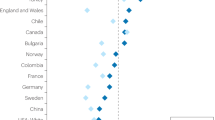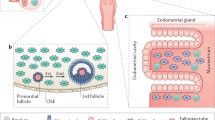Abstract
Objectives
Recent studies suggest that a proportion of ovarian tumors may actually originate in the distal fallopian tube. The objective of this study was to examine the relationship between dominance (a surrogate for site of origin) and survival, following a diagnosis of epithelial ovarian cancer.
Methods
We classified 1,386 tumors as dominant (putatively originating in the ovary) and non-dominant (putatively originating in the fallopian tube), using parameters obtained from pathology reports. Dominant tumors were restricted to one ovary or one involved ovary that exceeded the other in dimension by at least twofold, while non-dominant tumors were identified as having a greater likelihood of a tubal origin if the disease was equally distributed across the ovaries. Cox proportional hazards models were used to estimate the hazard ratios (HRs) and 95 % confidence intervals (CIs) associated with dominance.
Results
Non-dominant tumors were more likely to be serous, stage III/IV, and be associated with a BRCA1/2 mutation, increasing parity and use of estrogen hormone replacement therapy (p ≤ 0.01). In contrast, 46 and 26 % of the dominant tumors were serous and endometrioid, respectively, with a more even distribution of stage (p < 0.0001). Women with a non-dominant tumor had an increased risk of death compared to women with a dominant tumor (multivariate HR 1.28; 95 % CI 1.02–1.60). Findings were similar in our analysis restricted to serous only subtypes (HR 1.28; 95 % CI 1.01–1.63).
Conclusion
These preliminary findings suggest significantly worse survival among women diagnosed with a tumor putatively arising from fallopian tube.



Similar content being viewed by others
References
Vaughan S, Coward JI, Bast RC Jr, Berchuck A, Berek JS, Brenton JD, Coukos G, Crum CC, Drapkin R, Etemadmoghadam D, Friedlander M, Gabra H, Kaye SB, Lord CJ, Lengyel E, Levine DA, McNeish IA, Menon U, Mills GB, Nephew KP, Oza AM, Sood AK, Stronach EA, Walczak H, Bowtell DD, Balkwill FR (2011) Rethinking ovarian cancer: recommendations for improving outcomes. Nat Rev Cancer 11(10):719–725. doi:10.1038/nrc3144
Cannistra SA (2004) Cancer of the ovary. N Engl J Med 351(24):2519–2529. doi:10.1056/NEJMra041842
van der Velde NM, Mourits MJ, Arts HJ, de Vries J, Leegte BK, Dijkhuis G, Oosterwijk JC, de Bock GH (2009) Time to stop ovarian cancer screening in BRCA1/2 mutation carriers? Int J Cancer 124(4):919–923. doi:10.1002/ijc.24038
Barakat RR, Markman M, Randall ME (2009) Principles and practice of gynecologic oncology, 5th edn. Lippincott Williams and Wilkins, Baltimore
Berek JS, Crum C, Friedlander M (2012) Cancer of the ovary, fallopian tube, and peritoneum. Int J Gynaecol Obstet 119(Suppl. 2):S118–S129. doi:10.1016/S0020-7292(12)60025-3
Roh MH, Kindelberger D, Crum CP (2009) Serous tubal intraepithelial carcinoma and the dominant ovarian mass: clues to serous tumor origin? Am J Surg Pathol 33(3):376–383. doi:10.1097/PAS.0b013e3181868904
Carlson JW, Miron A, Jarboe EA, Parast MM, Hirsch MS, Lee Y, Muto MG, Kindelberger D, Crum CP (2008) Serous tubal intraepithelial carcinoma: its potential role in primary peritoneal serous carcinoma and serous cancer prevention. J Clin Oncol 26(25):4160–4165. doi:10.1200/JCO.2008.16.4814
Lee Y, Miron A, Drapkin R, Nucci MR, Medeiros F, Saleemuddin A, Garber J, Birch C, Mou H, Gordon RW, Cramer DW, McKeon FD, Crum CP (2007) A candidate precursor to serous carcinoma that originates in the distal fallopian tube. J Pathol 211(1):26–35. doi:10.1002/path.2091
Folkins AK, Jarboe EA, Roh MH, Crum CP (2009) Precursors to pelvic serous carcinoma and their clinical implications. Gynecol Oncol 113(3):391–396. doi:10.1016/j.ygyno.2009.01.013
Dubeau L (2008) The cell of origin of ovarian epithelial tumours. Lancet Oncol 9(12):1191–1197. doi:10.1016/S1470-2045(08)70308-5
Risch HA, Marrett LD, Jain M, Howe GR (1996) Differences in risk factors for epithelial ovarian cancer by histologic type. Results of a case–control study. Am J Epidemiol 144(4):363–372
Jarboe EA, Folkins AK, Drapkin R, Ince TA, Agoston ES, Crum CP (2008) Tubal and ovarian pathways to pelvic epithelial cancer: a pathological perspective. Histopathology 53(2):127–138. doi:10.1111/j.1365-2559.2007.02938.x
Medeiros F, Muto MG, Lee Y, Elvin JA, Callahan MJ, Feltmate C, Garber JE, Cramer DW, Crum CP (2006) The tubal fimbria is a preferred site for early adenocarcinoma in women with familial ovarian cancer syndrome. Am J Surg Pathol 30(2):230–236
Kotsopoulos J, Terry KL, Poole EM, Rosner B, Murphy MA, Hecht JL, Crum CP, Missmer SA, Cramer DW, Tworoger SS (2013) Ovarian cancer risk factors by tumor dominance, a surrogate for cell of origin. Int J Cancer 133(3):730–739. doi:10.1002/ijc.28064
Zhang S, Royer R, Li S, McLaughlin JR, Rosen B, Risch HA, Fan I, Bradley L, Shaw PA, Narod SA (2011) Frequencies of BRCA1 and BRCA2 mutations among 1,342 unselected patients with invasive ovarian cancer. Gynecol Oncol 121(2):353–357. doi:10.1016/j.ygyno.2011.01.020
Narod SA, Moody JR, Rosen B, Fan I, Risch A, Sun P, McLaughlin JR (2013) Estimating survival rates after ovarian cancer among women tested for BRCA1 and BRCA2 mutations. Clin Genet 83(3):232–237. doi:10.1111/j.1399-0004.2012.01906.x
Clarke EA, Marrett LD, Kreiger N (1991) Cancer registration in Ontario: a computer approach. IARC Sci Publ 95:246–257
McLaughlin JR, Rosen B, Moody J, Pal T, Fan I, Shaw PA, Risch HA, Sellers TA, Sun P, Narod SA (2013) Long-term ovarian cancer survival associated with mutation in BRCA1 or BRCA2. J Natl Cancer Inst 105(2):141–148. doi:10.1093/jnci/djs494
Greenland S (1989) Modeling and variable selection in epidemiologic analysis. Am J Public Health 79(3):340–349
Kurman RJ, Shih Ie M (2010) The origin and pathogenesis of epithelial ovarian cancer: a proposed unifying theory. Am J Surg Pathol 34(3):433–443. doi:10.1097/PAS.0b013e3181cf3d79
Bowtell DD (2010) The genesis and evolution of high-grade serous ovarian cancer. Nat Rev Cancer 10(11):803–808. doi:10.1038/nrc2946
Landen CN Jr, Birrer MJ, Sood AK (2008) Early events in the pathogenesis of epithelial ovarian cancer. J Clin Oncol 26(6):995–1005. doi:10.1200/JCO.2006.07.9970
Finch A, Shaw P, Rosen B, Murphy J, Narod SA, Colgan TJ (2006) Clinical and pathologic findings of prophylactic salpingo-oophorectomies in 159 BRCA1 and BRCA2 carriers. Gynecol Oncol 100(1):58–64. doi:10.1016/j.ygyno.2005.06.065
Kindelberger DW, Lee Y, Miron A, Hirsch MS, Feltmate C, Medeiros F, Callahan MJ, Garner EO, Gordon RW, Birch C, Berkowitz RS, Muto MG, Crum CP (2007) Intraepithelial carcinoma of the fimbria and pelvic serous carcinoma: evidence for a causal relationship. Am J Surg Pathol 31(2):161–169. doi:10.1097/01.pas.0000213335.40358.47
Cass I, Holschneider C, Datta N, Barbuto D, Walts AE, Karlan BY (2005) BRCA-mutation-associated fallopian tube carcinoma: a distinct clinical phenotype? Obstet Gynecol 106(6):1327–1334. doi:10.1097/01.AOG.0000187892.78392.3f
Folkins AK, Jarboe EA, Saleemuddin A, Lee Y, Callahan MJ, Drapkin R, Garber JE, Muto MG, Tworoger S, Crum CP (2008) A candidate precursor to pelvic serous cancer (p53 signature) and its prevalence in ovaries and fallopian tubes from women with BRCA mutations. Gynecol Oncol 109(2):168–173. doi:10.1016/j.ygyno.2008.01.012
Crum CP (2009) Intercepting pelvic cancer in the distal fallopian tube: theories and realities. Mol Oncol 3(2):165–170. doi:10.1016/j.molonc.2009.01.004
Callahan MJ, Crum CP, Medeiros F, Kindelberger DW, Elvin JA, Garber JE, Feltmate CM, Berkowitz RS, Muto MG (2007) Primary fallopian tube malignancies in BRCA-positive women undergoing surgery for ovarian cancer risk reduction. J Clin Oncol 25(25):3985–3990. doi:10.1200/JCO.2007.12.2622
Reade CJ, Finlayson S, McAlpine J, Tone AA, Fung-Kee-Fung M, Ferguson SE (2013) Risk-reducing salpingectomy in Canada: a survey of obstetrician-gynaecologists. J Obstet Gynaecol Can 35(7):627–634
Soslow RA, Han G, Park KJ, Garg K, Olvera N, Spriggs DR, Kauff ND, Levine DA (2012) Morphologic patterns associated with BRCA1 and BRCA2 genotype in ovarian carcinoma. Mod Pathol 25(4):625–636. doi:10.1038/modpathol.2011.183
Howitt BE, Hanamornroongruang S, Lin DI, Conner JE, Schulte S, Horowitz N, Crum CP, Meserve EE (2015) Evidence for a dualistic model of high-grade serous carcinoma: BRCA mutation status, histology, and tubal intraepithelial carcinoma. Am J Surg Pathol 39(3):287–293. doi:10.1097/PAS.0000000000000369
Bookman MA, Greer BE, Ozols RF (2003) Optimal therapy of advanced ovarian cancer: carboplatin and paclitaxel vs. cisplatin and paclitaxel (GOG 158) and an update on GOG0 182-ICON5. Int J Gynecol Cancer 13(6):735–740
Siegel R, Ward E, Brawley O, Jemal A (2011) Cancer statistics, 2011: the impact of eliminating socioeconomic and racial disparities on premature cancer deaths. CA Cancer J Clin 61(4):212–236. doi:10.3322/caac.20121
Reade CJ, McVey RM, Tone AA, Finlayson SJ, McAlpine JN, Fung-Kee-Fung M, Ferguson SE (2014) The fallopian tube as the origin of high grade serous ovarian cancer: review of a paradigm shift. J Obstet Gynaecol Can 36(2):133–140
Schenberg T, Mitchell G (2014) Prophylactic bilateral salpingectomy as a prevention strategy in women at high-risk of ovarian cancer: a mini-review. Front Oncol 4:21. doi:10.3389/fonc.2014.00021
Finch AP, Lubinski J, Moller P, Singer CF, Karlan B, Senter L, Rosen B, Maehle L, Ghadirian P, Cybulski C, Huzarski T, Eisen A, Foulkes WD, Kim-Sing C, Ainsworth P, Tung N, Lynch HT, Neuhausen S, Metcalfe KA, Thompson I, Murphy J, Sun P, Narod SA (2014) Impact of oophorectomy on cancer incidence and mortality in women with a BRCA1 or BRCA2 mutation. J Clin Oncol. doi:10.1200/JCO.2013.53.2820
Finch A, Narod SA (2011) Quality of life and health status after prophylactic salpingo-oophorectomy in women who carry a BRCA mutation: a review. Maturitas 70(3):261–265. doi:10.1016/j.maturitas.2011.08.001
Gilks CB, Miller D (2013) Opportunistic salpingectomy for women at low risk for development of ovarian carcinoma: the time has come. Gynecol Oncol 129(3):443–444. doi:10.1016/j.ygyno.2013.04.021
Hofstetter G, Concin N, Braicu I, Chekerov R, Sehouli J, Cadron I, Van Gorp T, Trillsch F, Mahner S, Ulmer H, Grimm C, Castillo-Tong DC, Zeillinger R, Zeimet AG, Vergote I (2013) The time interval from surgery to start of chemotherapy significantly impacts prognosis in patients with advanced serous ovarian carcinoma—analysis of patient data in the prospective OVCAD study. Gynecol Oncol 131(1):15–20. doi:10.1016/j.ygyno.2013.07.086
Shih Ie M, Kurman RJ (2004) Ovarian tumorigenesis: a proposed model based on morphological and molecular genetic analysis. Am J Pathol 164(5):1511–1518
Kurman RJ, Shih Ie M (2008) Pathogenesis of ovarian cancer: lessons from morphology and molecular biology and their clinical implications. Int J Gynecol Pathol 27(2):151–160. doi:10.1097/PGP.0b013e318161e4f5
Acknowledgments
Joanne Kotsopoulos is the recipient of a Cancer Care Ontario Research Chair in Population Studies and a Canadian Cancer Society Career Development Award in Prevention. Steven Narod is the recipient of a Canada Research Chair tier I. This study was supported by a Cancer Care Ontario—Population Sciences Research Network grant. The study was also supported by US National Institutes of Health grants R01-CA063678 (Narod) and R01-CA063682 (Risch).
Author information
Authors and Affiliations
Corresponding author
Rights and permissions
About this article
Cite this article
Ivanova, A., Loo, A., Tworoger, S. et al. Ovarian cancer survival by tumor dominance, a surrogate for site of origin. Cancer Causes Control 26, 601–608 (2015). https://doi.org/10.1007/s10552-015-0547-y
Received:
Accepted:
Published:
Issue Date:
DOI: https://doi.org/10.1007/s10552-015-0547-y




